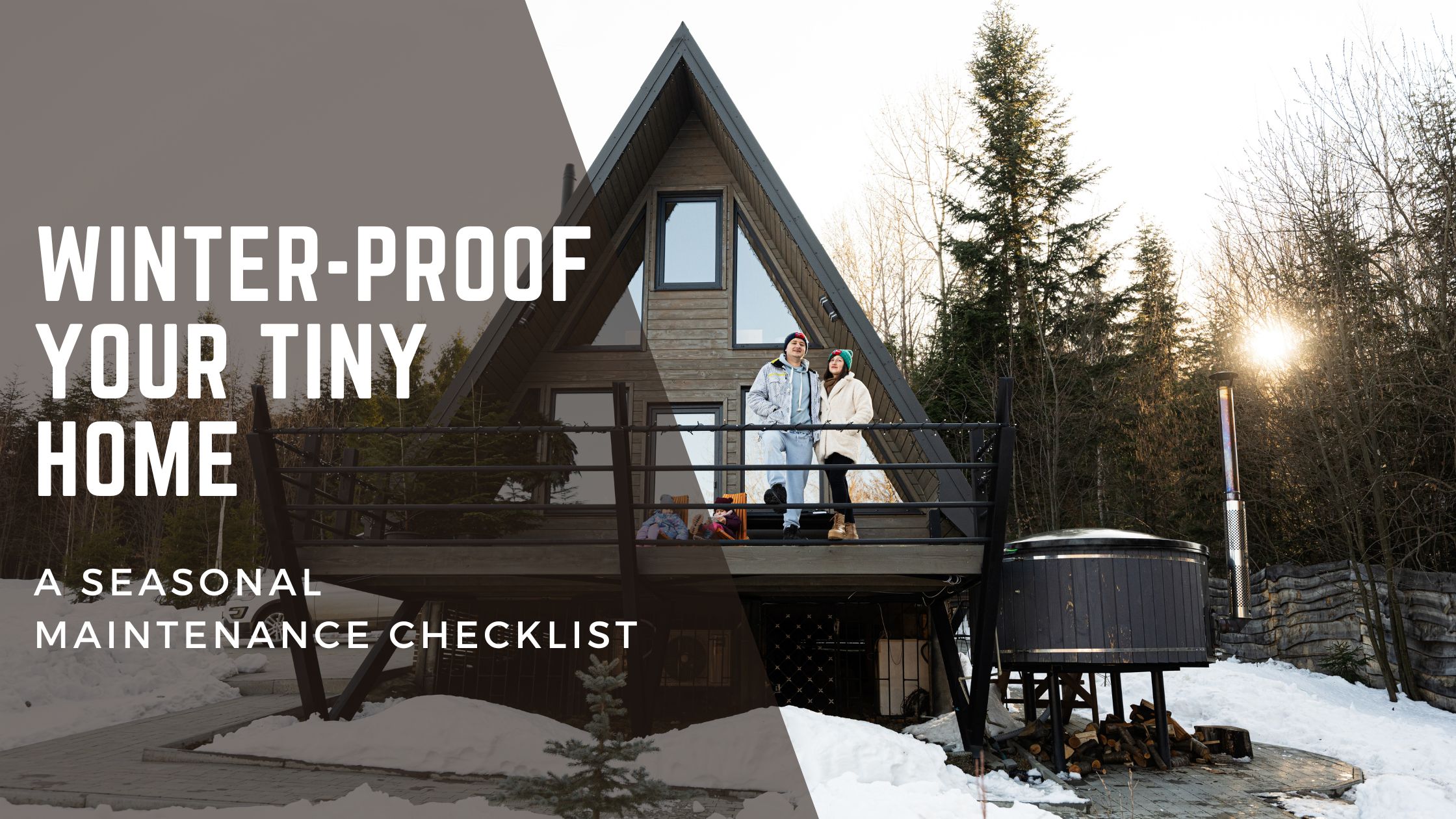
Preparing your tiny home for fall and winter helps you stay comfortable and avoid issues during the colder months. Follow these steps to keep your tiny home warm, efficient, and safe throughout the season.
Seal Doors and Windows to Prevent Drafts
Tiny homes are sensitive to drafts since even small gaps can make a noticeable difference in temperature. Here’s how to check and fix them:
- Inspect: Look for gaps around windows, doors, and any exterior vents.
- Seal: Use weatherstrips for doors and apply weatherproof caulk to seal any cracks around windows and vents.
This keeps you warmer and helps cut down on heating costs
Insulate and Protect Pipes from Freezing
Preventing frozen pipes is important for tiny home maintenance. Here’s what to do:
- Wrap Pipes: Insulate any exposed pipes, especially those located outside or in unheated spaces, with pipe insulation or heat tape.
- Drip Faucets: In extremely cold temperatures, allow faucets to drip slightly to prevent freezing.
Taking these steps avoids costly repairs and keeps your water flowing during the winter.
Clean Roof and Gutters
Keeping the roof and gutters clear of debris helps prevent leaks and ice dams. Here’s how:
- Remove Leaves and Debris: Clear gutters to allow proper drainage, especially in areas with heavy rainfall or snowfall.
- Check for Damage: Look for loose or damaged shingles and repair as needed to prevent leaks.
- Clean Solar Panels: If you have solar panels, give them a good clean before winter sets in. Snow and ice can reduce their efficiency, so keeping them clear of debris helps them work as effectively as possible.
For tiny homes with chimneys or wood stoves, clean them out to avoid build-up.
Prep Your Heating System
Efficient heating is essential for a tiny home in winter. Follow these steps:
- Service and Clean: Clean any air filters and vents, and check that your heating source (mini-split, wood stove, or electric) is working efficiently.
- Inspect Safety: Make sure that any portable heaters are safe and suitable for small spaces.
Emergency Kit and Essentials Stock-Up
Winter weather can be unpredictable, so be prepared with essentials:
- Fuel and Firewood: Keep enough firewood or fuel if you use a wood stove or gas heater.
- De-Icer and Snow Shovel: Keep these on hand for clearing paths if snow is expected.
- Non-Perishable Food and Water: Store a small supply of food and water in case of power outages.
- Blankets, Flashlights, and Batteries: Keep extra blankets for warmth, flashlights for light, and batteries for any battery-operated devices.
- First-Aid Supplies: Stock a basic first-aid kit with bandages, antiseptic, pain relievers, and any personal medications.
These basics keep you prepared for bad weather and emergencies.
Ensure Good Ventilation
Moisture build-up can be a problem in a small space. Here’s how to keep it dry:
- Ventilate Daily: Open a window or use an exhaust fan daily to let moisture escape.
- Use a Dehumidifier: If you’re in a particularly damp area, a compact dehumidifier helps reduce condensation and prevents mold.
Proper ventilation keeps your air fresh and protects against moisture-related damage.
Inspect and Weatherproof the Exterior
Protect the exterior of your tiny home to keep it weather-resistant:
- Check Seals: Apply weatherproof sealant on any exposed areas or small gaps.
- Inspect Tires and Stabilizers (for Tiny Homes on Wheels): Ensure tires are properly inflated, stabilizers are secure, and any exposed metal is protected from rust.
Routine exterior checks extend the life of your tiny home and keep it safe.
Test Smoke and Carbon Monoxide Detectors
Winter calls for extra attention to safety checks. Here’s a quick rundown:
- Test Alarms: Test smoke and carbon monoxide detectors, and replace batteries as needed.
- Check Fire Extinguishers: Make sure your fire extinguisher is in good condition and within reach.
These checks are quick but can be life-saving.
Keep Your Internet Connection Stable
Heating systems and smart devices in your tiny home often need the internet to work well, especially during winter storms when repair visits may be delayed.
A network management tool can help you keep your connection steady by:
- Tracking Internet Usage: See which devices are slowing down your network.
- Sending Alerts: Get notified if a device, like your smart thermostat, loses connection so you can fix it quickly.
- Easy Troubleshooting: Find and fix small issues before they become big problems.
This way, you can keep everything running smoothly, even in rough winter weather.
Conclusion
Taking the time now to handle these small tasks will help prevent bigger issues down the road, so you can relax and enjoy your cozy space, no matter how cold it gets outside. Stay warm and safe!
